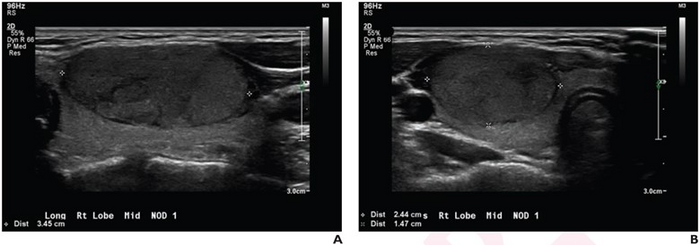Leesburg, VA, October 19, 2022—According to an accepted manuscript published in ARRS’ American Journal of Roentgenology (AJR), ACR TI-RADS and a deep learning algorithm trained on adult populations offer alternative strategies for evaluating thyroid nodules in children and younger adults, including guiding decisions to perform fine-needle aspiration.

Credit: ARRS/AJR
Leesburg, VA, October 19, 2022—According to an accepted manuscript published in ARRS’ American Journal of Roentgenology (AJR), ACR TI-RADS and a deep learning algorithm trained on adult populations offer alternative strategies for evaluating thyroid nodules in children and younger adults, including guiding decisions to perform fine-needle aspiration.
“Both ACR TI-RADS and the deep learning algorithm had higher sensitivity, albeit lower specificity, compared with radiologists’ overall impressions,” wrote co-first author Jichen Yang, BSE, from the department of electrical and computer engineering at Duke University in Durham, NC. Adding that the algorithm had similar sensitivity, but lower specificity, than ACR TI-RADS, “interobserver agreement was higher for ACR TI-RADS than for overall impressions,” Yang noted.
In this AJR accepted manuscript, 139 patients (119 female, 20 male) aged ≤21 years with a thyroid nodule on ultrasound with definitive pathologic results from fine-needle aspiration and/or surgical excision were evaluated from January 1, 2004 to September 18, 2020. Single transverse and longitudinal images of one nodule per patient were then extracted. Three radiologists independently characterized nodules based on overall impression (benign vs. malignant) and ACR TI-RADS. A previously developed deep learning algorithm determined malignancy likelihood for each nodule, which was used to derive risk level.
The code repository for Yang and colleagues’ deep learning algorithm is available here.
Ultimately, for evaluating thyroid nodules via ultrasound in children and young adults, radiologists’ overall impressions—representing the current standard clinical approach—had mean sensitivity of 58.3% and mean specificity of 79.9%; ACR TI-RADS had mean sensitivity of 85.1% and mean specificity of 50.6%, and a deep learning algorithm had sensitivity of 87.5% and specificity of 36.1%.
“Given the heightened priority for sensitivity when evaluating thyroid nodules in children, compared with in adults, the findings support the continued exploration in children of ACR TI-RADS and of the deep learning algorithm,” Yang et al. concluded in this AJR accepted manuscript.
An electronic supplement to this accepted manuscript is available here.
North America’s first radiological society, the American Roentgen Ray Society (ARRS) remains dedicated to the advancement of medicine through the profession of medical imaging and its allied sciences. An international forum for progress in radiology since the discovery of the x-ray, ARRS maintains its mission of improving health through a community committed to advancing knowledge and skills with the world’s longest continuously published radiology journal—American Journal of Roentgenology—the ARRS Annual Meeting, InPractice magazine, topical symposia, myriad multimedia educational materials, as well as awarding scholarships via The Roentgen Fund®.
MEDIA CONTACT:
Logan K. Young, PIO
44211 Slatestone Court
Leesburg, VA 20176
703-858-4332
Journal
American Journal of Roentgenology
DOI
10.2214/AJR.22.28231
Method of Research
Imaging analysis
Subject of Research
People
Article Title
Thyroid Nodules on Ultrasound in Children and Young Adults: Comparison of Diagnostic Performance of Radiologists’ Impressions, ACR TI-RADS, and a Deep Learning Algorithm
Article Publication Date
19-Oct-2022




